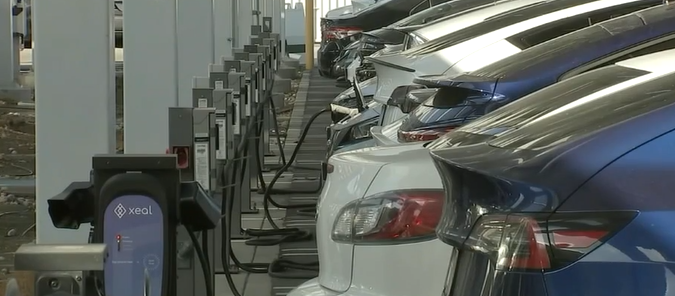Copper wire thieves target electric vehicle chargers across Los Angeles

By Josh Haskell
Click here for updates on this story
LOS ANGELES (KABC) — Could copper theft slow Los Angeles’s move towards a zero-emissions future? Thieves are targeting electric vehicle charging stations for copper wire — cutting cords and even breaking into chargers using hacksaws. It’s a costly fix to repair the vandalized stations.
Now, there are new efforts underway to prevent copper wire theft.
“All our focus is, ‘How do we accelerate transportation electrification?’ More EVs, cars and trucks on the road, more charges in the ground by the time the world arrives for the Olympic and Paralympic Games in 2028. How do we show the world what we’re made of? We don’t want to show them a world where the Sixth Street Bridge and all the EV chargers are clipped with copper theft,” said Matt Petersen, the CEO of Los Angeles Cleantech Incubator (LACI).
Even Petersen’s non-profit in the Arts District has been hit multiple times. According to LACI, there are 60,630 public and workplace EV chargers in the greater Los Angeles region.
“There are more chargers that are now out in the open, so it becomes easily accessible to access those, and metal prices are increasing. Copper has increased over the years, so that’s also leading to more vandalism,” said Aric Ohana, of Ohana Mobility.AI.
“Cutting a connector doesn’t fall underneath warranty, and so when you start there, it can get quite expensive, specifically because it’s going to come out of the pocket of the person that deployed the charging station,” said Kameale Terry, the CEO of Charger Help. “For level two, slower chargers, you’re seeing anywhere between $650 to $700 for the connector plus the labor. But then, when you start talking about DC fast chargers, it can go all the way up to $1,500.”
Those in the EV community support AB 476, which Gov. Gavin Newsom just signed into law. It brings stricter penalties and enforcement to those paying for the stolen metal, something that’s not worth a lot of money.
EV charging companies are coming up with more innovative ways to prevent cables from being cut. That includes cables that can disconnect from the charger, wireless charging and more durable protection for cords, including one cable that sprays ink when it’s cut.
“As we see these problems, let’s quantify them. Let’s ensure that we’re thinking about how we solve them. But most importantly, let’s lean in and build better products where you can’t just simply cut the connector,” Terry said.
Please note: This content carries a strict local market embargo. If you share the same market as the contributor of this article, you may not use it on any platform.